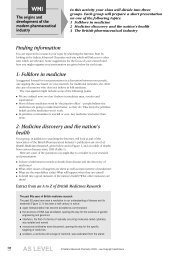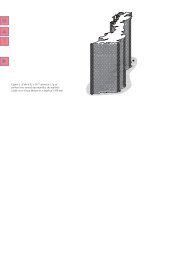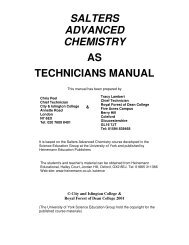Module 3 - Benjamin-Mills
Module 3 - Benjamin-Mills
Module 3 - Benjamin-Mills
You also want an ePaper? Increase the reach of your titles
YUMPU automatically turns print PDFs into web optimized ePapers that Google loves.
SS2.5<br />
WHICH IS THE RIGHT STEEL FOR THE JOB?<br />
Information Sheet: Some elements and their<br />
effects on the properties of steel<br />
Nickel<br />
Nickel promotes toughness at low<br />
temperatures and reduces the<br />
chances of brittle fractures.<br />
Nickel is relatively inert and<br />
improves the corrosion resistance of<br />
steel. Up to 8% nickel is used in<br />
some stainless steels.<br />
Niobium<br />
Niobium forms an extremely hard and stable carbide.<br />
It is added to some stainless steels to increase<br />
resistance to corrosion and is also a constitutent of<br />
abrasion-resistant steels and steels to be used at<br />
high temperatures.<br />
Nitrogen<br />
All steels contain some dissolved nitrogen from the air.<br />
Generally nitrogen is undesirable in steel because it<br />
makes the metal less ductile.<br />
Copper<br />
Copper is added to steel to increase corrosion<br />
resistance. It also increases strength. Scrap electrical<br />
motors are often used as the source of copper.<br />
Aluminium<br />
Aluminium is often added to the molten metal<br />
because it forms a fine precipitate of<br />
aluminium nitride as the steel solidifies; this<br />
limits the size of the crystals formed in the<br />
cooling metal. The resulting material can be<br />
easily shaped, yet is tough and has good<br />
impact resistance. Aluminium is added to steel<br />
for car body panels, but is kept to a minimum<br />
in steel which is to be drawn out into wire, as<br />
regions of aluminium oxide tend to cause<br />
breakages.<br />
Chromium<br />
Chromium makes steel resistant to corrosion.<br />
Stainless steel contains 12-25% chromium.<br />
Chromium also improves wear resistance and<br />
helps steel to retain its strength at high<br />
temperatures (used in high-speed tools).<br />
Carbon<br />
Carbon is the most important alloying element in<br />
steel. By changing the carbon content a wide<br />
variety of mechanical properties can be produced:<br />
• Metal from the blast furnace (4% C) is very<br />
brittle.<br />
• High-carbon steel (1% C) is strong and resistant<br />
to hard wear.<br />
• Low-carbon or mild steel (0.008% C) is less<br />
strong but easily moulded.<br />
Manganese<br />
Manganese is the most used alloying metal in<br />
steel. Manganese improves the quality of steel<br />
by making it easier to work when hot and<br />
increasing hardness when cold. Manganese<br />
combines with residual sulphur to form small,<br />
evenly distributed sulphide crystals. It is present<br />
in all steels but is particularly important in<br />
steels used to make tools and dies.<br />
Silicon<br />
Silicon is added to most steels because small<br />
amounts improve the hardness and strength of<br />
the alloy.<br />
METHANE<br />
Phosphorus<br />
Small amounts of phosphorus severely reduce the<br />
quality of steel by reducing ductility. Ordinary<br />
steels have concentrations less than 0.04% but<br />
many steel specifications where cracking would<br />
be a very serious problem (such as in a gas<br />
pipeline) require the phosphorus concentration to<br />
be as low as 0.005%.<br />
Sulphur<br />
Usually much care is taken by steelmakers to<br />
reduce the sulphur content of steel. Sulphur<br />
increases corrosion rate, promotes stress<br />
corrosion cracking and increases brittleness at<br />
low temperatures. The development of the offshore<br />
and arctic oil industry has increased the<br />
demand for high-grade steels with very low<br />
sulphur content.<br />
However, small amounts of sulphur (0.08-<br />
0.13%) make it easier to machine the metal.<br />
Steel chips break away more easily during<br />
machining if there is iron sulphide present. This<br />
reduces tool wear and the volume of turning<br />
waste.<br />
Vanadium<br />
Vanadium promotes small crystal size in steels<br />
and increases the strength, hardness and wear<br />
resistance. It is an expensive addition to steel<br />
and so it is only used where the steel will<br />
experience exceptionally severe service, such<br />
as in tools and dies, structural steels for<br />
military vehicles, and rails (curves, switches<br />
and points).<br />
Lead<br />
Lead improves the machinability of steel.<br />
Small quantities are added to steel which is<br />
intricately machined into gears and shafts<br />
because it helps to cut down on wear of tools.<br />
Machine operators must take precautions to<br />
avoid lead poisoning when working with these<br />
steels.<br />
Soda Stream<br />
Hydrogen<br />
Steelmakers go to considerable lengths<br />
to limit the hydrogen in steel. Hydrogen<br />
is produced when any moisture comes<br />
into contact with the molten steel.<br />
Fe + H 2<br />
O Æ FeO + H 2<br />
Atomic hydrogen in steel migrates to<br />
internal defects where it forms hydrogen<br />
gas and builds up high pressures. This<br />
can cause flaking at the surface and<br />
even fracturing in such items as<br />
pipelines.<br />
Tellurium<br />
Tellurium is added to steels to improve<br />
machinability, either alone or with lead. Fumes from<br />
tellurium compounds can be noxious and proper<br />
venting must be provided whenever additions are<br />
made – otherwise workers can develop ‘tellurium<br />
breath’, with a strong garlic-like odour.<br />
GALVANOMETER<br />
Molybdenum<br />
Molybdenum is a valuable additive for the hardening of steel. It<br />
retards the softening of steel at high temperatures and improves the<br />
corrosion resistance of stainless steels. Molybdenum is used in steels<br />
for boilers, high-speed tools and for special stainless steels used for<br />
cladding oil-rig modules and for containers for corrosive liquids.<br />
Tungsten<br />
Tungsten is an important additive to<br />
high-speed tool steels. It forms hard<br />
carbides which have high abrasion<br />
resistance. It helps to retain high<br />
strength in steels at high temperature.<br />
It is used in fire-resistant construction<br />
steels.<br />
214<br />
„ Salters Advanced Chemistry 2000 – see Copyright restrictions

















![ISI Web of Knowledge [v.4.10] - All Databases Results - Benjamin-Mills](https://img.yumpu.com/39253071/1/184x260/isi-web-of-knowledge-v410-all-databases-results-benjamin-mills.jpg?quality=85)